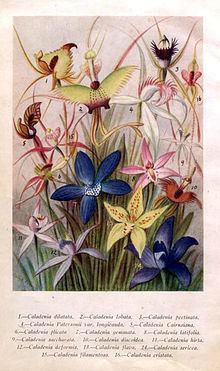Family Orchidaceae Rank Species | ||
 | ||
Similar Caladenia carnea, Caladenia gracilis, Caladenia alpina, Caladenia catenata | ||
Caladenia dilatata, commonly known as green comb spider orchid, is a deciduous terrestrial orchid species found throughout southern Australia.
Contents
Morphology
Caladenia dilatata is a terrestrial orchid that consists of a single large, flower. The plant itself grows 15 - 35 tall, from two round tubers that are protected in a fibrous tunic. It has one green basal leaf that is long and hairy.
Similar to other spider orchids, the flower consists of four long, lanceolate and curved filamentous modified sepals. The sepals are green-yellow, with a maroon color on the dorsal side, measuring up to 5 – 5.5 cm long. They droop downwards and taper into fine, yellow-brown clubbed tips that are covered with dark-colored hairs. The pair of basal sepals spread away from each other, but may also curve and cross.
The flower also consists of an egg-shaped green labellum that is a dark maroon on the lateral side with four rows of calli towards the center. The lateral margins of the labellum are green and lobed, with the lobes erect. The front margins are fringed and the mid-lobe is curved downwards.
It grows in response to soaking rains, producing only a leaf that will remain dormant during the winter season. However, the flower may be aborted in severely dry weather.
Taxonomy and naming
Caladenia dilatata was first formally described in 1810 by Robert Brown from a specimen collected at Port Dalrymple at the mouth of the Tamar River near Georgetown. The description was published in Prodromus Florae Novae Hollandiae.
Distribution
Green comb spider orchid is found in New South Wales, Queensland, Victoria, South Australia, as well as Tasmania. Not an abundant species, it more commonly thrives in areas of high rainfall, at elevations varying between 5 – 100 meters in heathlands and coastal scrublands. It can also occur in severely fragmented habitats amongst rocks and granite outcrops, tolerating dry, exposed environments, as well as clay, loam, sandy, and well-drained soil types.
It flowers in late spring in Australia, between October and December.
Reproduction
The flower of this orchid closes after pollination, forming a papery capsule. Yellow, brown, or black dust-sized seeds are produced in the capsule, which dries and splits open at maturity, releasing millions of seeds that are dispersed by wind or water. However, the seeds only germinate upon infection by mycorrhizal fungus, and so few seeds mature into full plants.
Ecology
The elongated tips of the flower produces sexual attractants and attracts pollinators in pseudocopulation, where the pollinators think the flower is a female. Thynnid wasps are often attracted to the flower with the notion of copulating with the flower.
Caladenia dilatata has a mutalistic relationship with mycorrhizal fungi, where the fungus acquires some nutrition from the orchid, and the orchid requires the fungus to germinate. However, the orchid’s dependence on the fungus is not well known.
Although the orchid’s fire ecology is not well understood, it is believed that forest fires help clear surrounding vegetation, increasing light levels and temperature at ground level. With fewer competing plants, there is also believed to be an increase in moisture levels that can benefit Caladenia dilatata.
Food
The indigenous name of Caladenia dilatata is koolin, and its tubers are consumed, either raw or baked, by Coranderrk aboriginals.
